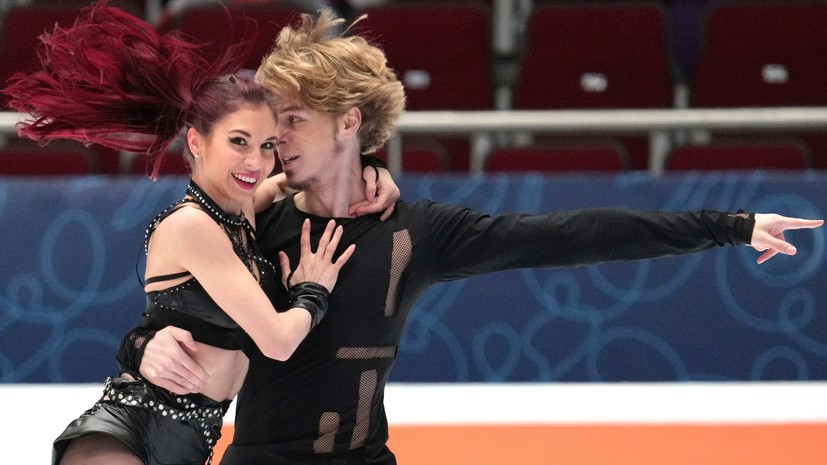Probably, for the first time in many years, the main attention of people, one way or another involved in ice dancing, was focused not on the leaders - the current world champions Victoria Sinitsina and Nikita Katsalapov, but on Diana Davis and Gleb Smolkin - the junior pair of Igor Shpilband, who has no in my heart absolutely no achievements, except for the won this year's Challenger tournament in Warsaw.
The debut at the adult level turned out to be crushing: Davis / Smolkin scored 81.30 in rhythm dance, added 118.60 to the result for an arbitrary rental, and this meant that newcomers in real time were turning from a duo-no-name into direct rivals of the second pair of the country - prize-winners of four European championships Alexandra Stepanova and Ivan Bukin.
Those a little earlier performed in the Grand Prix series at the stages in Turin and Grenoble, showed in each of the programs an absolutely comparable result with the Warsaw Davis / Smolkin points, but the technique was lost in both dances.
After that, the coaching staff of Stepanova and Bukin took a step that was not very popular in figure skating: they attracted two very strong specialists to prepare their duet - Nikolai Morozov and Alexei Gorshkov.
Commenting on the priority tasks, Morozov then said that the current situation strongly reminds him of the period of work with Elena Ilinykh and Nikita Katsalapov, when they were preparing for the Sochi Olympics and could not get ahead of Ekaterina Bobrova / Dmitry Solovyov.
But they did it at the very last moment during the personal Olympic tournament.
“The same task is now facing Stepanova and Bukin. I think they are really capable of fighting for an Olympic medal. I see a certain progress in their skating already now, the plan of our joint preparation has been built before the Russian Championship and, I am sure, the audience will be able to evaluate everything there themselves, ”the coach added.
The first start of the duo in St. Petersburg showed that the measure became extremely timely: in a few weeks of work, Stepanova and Bukin achieved real changes not only technically, but began to look different even outwardly. The assessments were also corresponding: in the rhythm dance, Alexander and Ivan were ahead of the debutants by almost five points. They lost in only one aspect: Diana and Gleb earned the highest, fourth level of difficulty for the blues pattern (which rarely happens in dances even at the level of fighting for medals in large tournaments), and Stepanova and Bukin - the third.
But here it was worth remembering that Igor Shpilband, one of the world's best techies, has been preparing the first of these duets for three years in the United States, and the skaters really made absolutely incredible progress under his leadership. And they made more than a serious bid to knock out Tiffany Zagorski / Jonathan Gureiro, the most experienced couple of Svetlana Alekseeva and Elena Kustarova, from the Olympic team. The difference in points after performing the rhythm dance was 4.63 in favor of Diana and Gleb, and they received five points of advantage in the assessment for the technique. Tiffany and John summed up the step sequence in the center (the second level of difficulty against the third) and the first level for the pattern.
Whether it was fair or not is difficult to judge.
The athletes themselves and their coaches were shocked after the marks were given - it was evident from their faces.
However, at the Grand Prix stage in Grenoble, Stepanova and Bukin received the same first level for the pattern, and the main coach of the duet, Alexander Svinin, said then on this occasion that it is extremely difficult to dispute such things in dancing.
“Here you really have to choose: either to file a protest immediately after the skate, which is simply not practiced in dancing, or to take all the referees' comments into consideration.
In single skating, it is easier: if the athlete did not tighten the jump and fell, this is an obvious mistake.
But when a dancer performs a brace or choctaw in the step sequence, if you wish, you can find fault with everything, ”the specialist explained.
Shpilband, commenting on the performance of the wards, noted: at the very beginning of this season, he did not even have a thought that Davis and Smolkin would be able to claim a place in the Olympic team.
According to the specialist, despite a very high result in rhythm dance, the athletes were still not as relaxed as they could, due to not only acclimatization and lack of sleep, but also a purely technical reason - the first start number.
“It is very difficult to skate when the hall has not yet been saturated with the energy of the competition.
This energy usually gives additional strength, you really feel it, being on the ice, ”the coach explained.
Sinitsina and Katsalapov became the first with a solid margin, as befits the reigning world and European champions.
The result of 93.61 points exceeded the level of the current world record, but could not be officially recognized due to the internal status of the tournament.
But this did not detract from the fact that the rhythm dance performed by the strongest Russian couple turned out to be outstanding.

